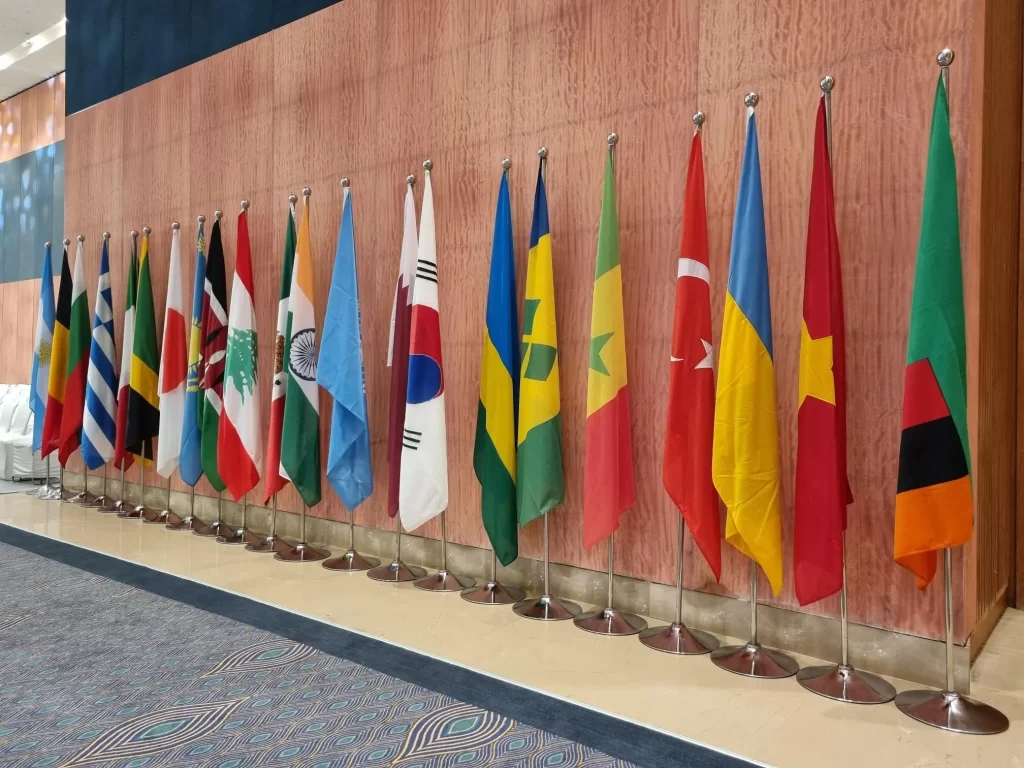In News
The 46th World Heritage Committee Meeting will be hosted by India for the first time at Bharath Mandapam from July 21-31, 2024.
World Heritage sites belong to all the peoples of the world, irrespective of the territory on which they are located.
The World Heritage Convention addresses climate change, rapid urbanization, mass tourism, sustainable socio-economic development, and natural disasters, among other contemporary challenges. The World Heritage Committee is responsible for the implementation of the World Heritage Convention. It allocates financial assistance from the World Heritage Fund and has the final say on whether a site is inscribed on the World Heritage List.
Importance of World Heritage Committee for India
- India has a vastness of living and diverse cultural traditions, traditional expressions, and intangible cultural heritage that need institutional support, better technology, capacity, communication, community, and credibility for conservation, which the committee offers.
- It helps India showcase its culture on the global arena, promoting tourism and values. The logo of the meeting was the stone chariot from the Vijaya Vitthala Temple, Hampi, with the tagline ‘May our Glory Grow,’ derived from the ‘Taitiriya Upanishad.’ During the meeting, the PM mentioned the historic ‘Moidams’ of the North East, a mound-burial system of the Ahom dynasty in Assam, which was nominated for inclusion in the World Heritage List and later got included.
- It compliments India’s efforts in education and research in heritage.
- The best practices displayed across nations in the committee are useful for adoption in India.
- Historical cultural ties, like trade with Mesopotamia by the Indus Valley Civilization (IVC), Mauryans with Sri Lanka, and Cholas with Southeast Asia, help strengthen ties with other nations through soft power diplomacy. In the meeting, the PM emphasized the global nature of heritage and announced India’s USD 1 million contribution to the UNESCO World Heritage Centre, focusing on benefiting countries in the Global South.
Indian Heritage and its Need to be Conserved
India has inscribed 43 properties in the World Heritage List (35 Cultural, 7 Natural, 1 Mixed Heritage Site). India is the 6th country on the list and 2nd in the Asia Pacific Region based on the number of World Heritage sites.
- The declaration of Khangchendzonga National Park under the Man and Biosphere programme ensures the unique diversity of valleys, mountains, ancient forests with orchid and rhododendron diversity, and animal species diversity, including six cat species, red pandas, Tibetan wolves, Himalayan tahrs, and sacred lands of Buddhists (Beyul) and Lepchas as Mayel Lyang. This exchange between different religious traditions and ethnicities makes the identity and unity of Sikkim’s people and keeps them connected with their ancestors. The indigenous traditional knowledge of local plants and the local ecosystem is vital for saving endemic plant varieties and the healthy well-being of societies. The traditional and ritual management system of forests and natural resources by Buddhist monasteries could help in conservation, linking nature conservation with the preservation of cultural sites.
- Shows glory of nation, unity and diversity of different customs and traditions like the 2000-year-old Iron Pillar which has been rust-resistant, Brihadeeswara Temple in the South of India built by Chola, Warli paintings, Dhokra metal craft, Durga pooja. .
- The Patan Patola Saris of Gujarat, which prospered duting 12th and 13th centuary now worth several lakhs. In 2014, Patan Patola Heritage (PPH), an ingeniously curated museum comprising oldest pieces of patola with 200-year-old frock, old family saris and samples of ikat textiles from countries like Thailand, Uzbekistan, Philippines and Indonesia was established. This shows how Economic Growth can be achieved through tourism and employing the local population by conserving heritage..
- Emphasizing India’s effort to be a partner in global welfare by global embrace of Yoga and Ayurveda, the scientific heritage of India.
- Dholavira and Hampi known for urban planning, artifacts and the intricate water conservation system will blow ones mind.
- Creating heritage cities like Srinagar – City of Crafts, and Kozhikode – City of Literature demonstrates how smart cities can contribute to achieving the SDG goals defined in the 2030 Agenda.
- Santiniketan, an adobe of learning, educated Santals through its activities on rural reconstruction of nearby villages, its human and environment-friendly educational system, annual festivals such as Basant Utsav and Poush Utsav, and tribal dances, while preserving Bengal’s fast-disappearing rural crafts culture through folk markets like the weekly Bondangaar Haat and rural cooperatives like Amar Kutir.
Challenges in Conserving
- Plundering of Artifacts: Chandraketugarh, a civilization that existed from the 5th BCE to the 12th CE, is now in ruins, with many artifacts plundered and scattered around the world, housed in top museums and private collections.
- Climate Change: According to UNESCO, 1 in 3 natural sites and 1 in 6 cultural heritage sites are currently threatened by climate change globally. Landslides in the Western Ghats affect pristine forest ecology and the livelihoods of humans; pollution is damaging monuments, causing discoloration of the Taj Mahal; mining is destroying sacred groves (like Niyamgiri Hills in Odisha) and disrupting conservation efforts as well as livelihoods.
- Demolition: Demolitions for city expansion and accommodating people are undertaken. Procedures for both administrative and legal clearance have been approved for the demolition of two iconic structures that dominated the cityscape for decades—the Devaraja Market and the Lansdowne Building, both over 125 years old, in Karnataka.
- Encroachment and Vandalism: Monuments are facing encroachment and vandalism issues.
CAG Report 2021-22
- Policy Paralysis: No national policy on archaeological exploration and excavation.
- Funding Issues: The ASI budget for exploration and excavations is less than 1 percent.
- Lack of Synergy Between Agencies: The National Culture Fund, established in November 1996 to engage individuals and corporate groups to fund conservation, has utilized only 14 percent of its funds due to a lack of coordination with the ASI.
- Lack of Efficiency: The National Monuments Authority, a statutory body for implementing heritage by-laws and site plans for each monument, has only finalized and notified 31 monuments—a fraction of the 3,693 monuments on the list of Centrally Protected Monuments.
- Lack of Maintenance: Issues related to ASI-protected sites and the lack of follow-up, e.g., the Buddhist stupa site of Kanaganahalli in Karnataka.
Initiatives by India
- Constitutional Obligations:
- DPSP, Article 49 states that the state shall protect every monument or place of artistic or historic interest declared of national importance by Parliament.
- Fundamental Duty, Article 51A, emphasizes the duty of every citizen to value and preserve India’s rich heritage.
- Legal Provisions:
- Antiquities and Art Treasures Act, 1972
- Ancient Monuments and Archaeological Sites and Remains Act (AMASR Act) of 1958
- Institutions:
- Archaeological Survey of India (ASI)
- National Monuments Authority
- Schemes:
- Adopt a Heritage 2.0 with assistance from ASI
- National Mission on Monuments and Antiquities (NMMA), 2007
- HRIDAY
- Project Mausam
- Scheme for Safeguarding the Intangible Heritage and Diverse Cultural Traditions of India by the Ministry of Culture
- Indian Digital Heritage (IDH) Project (Digital Hampi)
- Indian Heritage in Digital Space Research
- Mission:
- Gandhi Mission on Manuscripts
- National Mission on Manuscripts
- National Mission on Cultural Mapping and Road Map
- Collaboration:
- Government bodies such as the ASI, along with NGOs like INTACH and ITRHD, actively contribute to preserving India’s heritage.
- Virtual Tours: The Rajdharaa project is developing virtual tours of heritage sites and museums in Rajasthan and Gujarat. The Ministry of Tourism partnered with Google to create virtual walkthroughs of famous historical places.
- Digital Preservation: The Gateway of India was selected by CyArk, an international NGO, as part of their international programme for digital preservation, collaborating with ASI.
Solutions for Conservation
The 5 Cs given by the World Heritage Convention of UNESCO—credibility, conservation, capacity building, communication, and communities—need to be addressed.
- Strengthen the AMASR Act of 1958.
- Enhance funding, ensure efficient and expert personnel, and promote a multidisciplinary approach and coordination between various institutions and the central and state governments.
- Emphasize the role of local communities and NGOs while spreading awareness in society.
- Utilize GIS to create a national database in collaboration with ISRO and the Ministry of Culture.
- Adopt technology such as LiDAR and 3D Laser Scanning through collaboration with NGOs and research teams. Examples from Italy, China, and Spain can be explored for digital preservation.
- Link heritage conservation with climate action plans; for instance, the Rainwater Harvesting Systems of Ancient Mandu can help address current drought issues in central India.
- Provide more incentives for adaptive reuse, renovation, retrofitting, or restoration of decaying buildings to promote sustainable urban development, preserve cultural heritage, and innovate space utilization, as seen in big cities like Mumbai and Delhi.
- Incorporate archaeology and heritage conservation in education.
- Encourage public participation by involving local politicians at the panchayat and district board levels to tighten vigilance and help control local trafficking agents.
United Nations Educational, Scientific and Cultural Organization (UNESCO)
UNESCO contributes to peace and security by promoting knowledge sharing and international cooperation in education, sciences, culture, communication, and information, and facilitating the free flow of ideas to accelerate mutual understanding and a more profound knowledge of each other’s lives. UNESCO’s programmes contribute to achieving the SDG goals defined in the 2030 Agenda, adopted by the UN General Assembly in 2015.
World Heritage Convention
Adopted in 1972 at the general conference of UNESCO, the World Heritage Convention links the conservation of natural and cultural heritage through five strategic objectives: credibility, conservation, capacity-building, communication, and communities for sustainable, comprehensive, and inclusive implementation.


